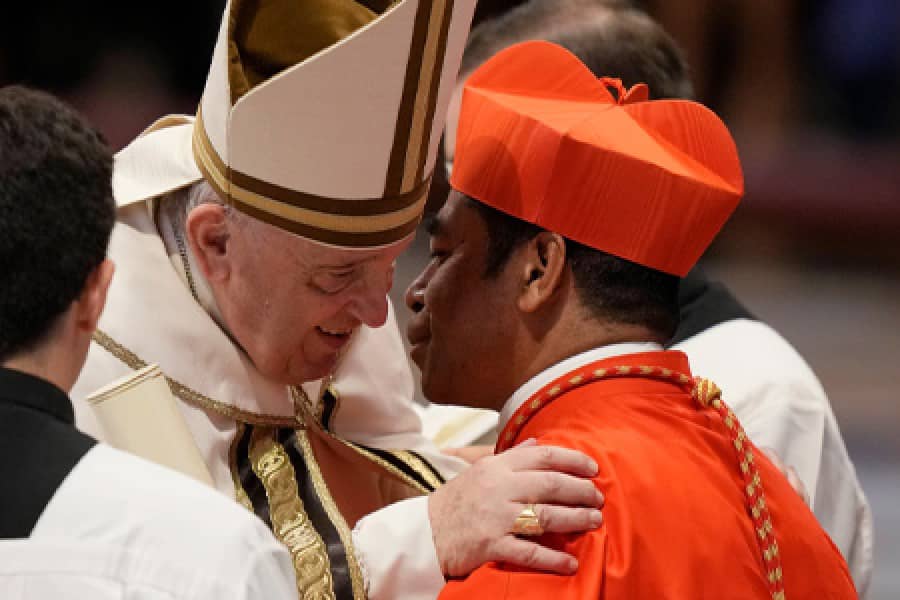 ROME— If there were an Apostle’s Creed for journalists, encapsulating the core beliefs of the trade, it would probably include these two points: First, facts matter, and second, if you’re going to tell a story, get the context right.
ROME— If there were an Apostle’s Creed for journalists, encapsulating the core beliefs of the trade, it would probably include these two points: First, facts matter, and second, if you’re going to tell a story, get the context right.
Recently at Crux, we’ve had occasion to do some healthy self-criticism on both fronts.
On Sunday, we posted a piece from one of the news agencies to which we subscribe and made a factual mistake in our headline by claiming Archbishop Charles Chaput of Philadelphia had written something he hadn’t.
(In a nutshell, Chaput suggested in a column that Notre Dame might invite President Donald Trump to speak, while the headline and article on Crux had it that Chaput wanted Notre Dame to “honor” Trump — obviously, two different things.)
Our philosophy is that when we unintentionally misrepresent someone, we try to make the correction matter. We’ll not only acknowledge it, but we’ll do our best to make sure our readers see it.
RELATED: Editor’s Note about Sunday article on Chaput and Trump
To my memory, in the last three years we’ve made such a mistake in a serious way twice: During one of the Synods of Bishops on the family, when we misquoted Cardinal Wilfrid Napier of South Africa, and on Sunday, when we misquoted Chaput. (The fact that in the latter case it was a wire story doesn’t change the fact it ran on our site, and we have to be responsible for it.)
I pretty much lost track of what happened the first time, but our readers kept coming and sources still answer the phone. This second time, however, I paid closer attention to the reactions, which we got via email and social media. I must admit I was surprised by how varied they were.
One of our readers, to my surprise, found it “shameful” that we would acknowledge the mistake and correct it. To clarify: the problem, according to this reader, wasn’t that we made a mistake, but that we’d dare correct it. Because, I guess, facts don’t matter.
To be fair, other people did applaud our integrity. I was dismayed, however, to see how often trying to get our facts right was interpreted as a political act intended to serve some agenda, rather than simply being the core of good journalistic tradecraft.
Since I’m on a roll acknowledging Crux mistakes, allow me to point out another one — in this case, not an error of fact, but of emphasis and interpretation in the way we’ve presented a critically important story.
Like every other Catholic news outlet on the planet, we’ve been covering the debate over Pope Francis’s document on the family, Amoris Laetitia, extremely closely. And, like most of those other outlets, a huge share of our coverage has focused on the one point from the document seen by both sides in the argument as tantamount to Armageddon: A footnote dealing with Communion for divorced and civilly remarried Catholics.
In case you haven’t read it, here is a screen-capture of the footnote, taken from the official Vatican web site:

In the media’s defense, bishops who have released guidelines on Amoris have made it all too easy to focus primarily on the footnote, because they often seem to as well. Further, if our traffic numbers are anything to go by, headlines which combine “Amoris-Communion-remarried-bishop says x” are apparently clickbait: people want to read about this, no matter who the bishop is or if the guidelines affect them or not.
RELATED: As recent guidelines show, ‘Amoris’ argument is far from over
However, I have to admit that by focusing so much of our coverage on this one point, we’ve failed in getting across a much bigger picture of what families struggle with today and what married life is about.
For Pope Francis, who penned the document on the family after a three-year process of consultation including two synods of bishops, the footnote is in fact, “not the important problem.”
This is what he had to say about it on his return from a day trip to the Greek island of Lesbos, where he went to try to bring the world’s attention to the drama of refugees:
“One of the recent popes, speaking of the Council, said that there were two councils: the Second Vatican Council in the Basilica of St. Peter, and the other, the council of the media. When I convoked the first synod, the great concern of the majority of the media was communion for the divorced and remarried, and, since I am not a saint, this bothered me, and then made me sad.
“Because, thinking of those media who said, this, this and that, do you not realize that that is not the important problem? Don’t you realize that instead the family throughout the world is in crisis? Don’t we realize that the falling birth rate in Europe is enough to make one cry? And the family is the basis of society. Do you not realize that the youth don’t want to marry? Don’t you realize that the fall of the birth rate in Europe is something to cry about? Don’t you realize that the lack of work or the little work (available) means that a mother has to get two jobs and the children grow up alone?
“These are the big problems. I don’t remember the footnote, but for sure if it’s something general in a footnote it’s because I spoke about it, I think, in ‘Evangelii Gaudium.’”
He restated this in January, when meeting with the Vatican’s judges [a body known as the Roman Rota] he skipped the usual reminder on reform of the marriage annulment process, focusing instead on what he sees as the need to improve the Church’s marriage preparation process.
RELATED: Pope to judges: Focus on marriage prep to avoid annulments
To the best of our knowledge, none of our Amoris coverage has been factually inaccurate, and it’s certainly not as if we’ll stop reporting the latest twists and turns in the Communion debate — I had a piece on the subject just yesterday, capturing an apparent clash between the German bishops and the Vatican’s German doctrinal czar.
Yet we also have to remind ourselves once in a while that when news coverage becomes fixated on one issue, Crux’s coverage included, key parts of the story can go untold. We’ll try to do a better job.

















